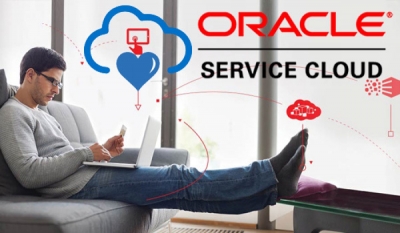Yet, one of those offerings in particular has a great shot at becoming an enterprise staple, and a long-term platform for IT innovation—database as a service.
Indeed, Larry Ellison, Executive Chairman and CTO of Oracle made this prediction recently: “Database is our largest software business and database will be our largest cloud business.”
A database cloud service, or database as a service (DBaaS), makes database capabilities available online, when and where those capabilities are needed.
The user can access a slice of a database (a schema), or, more likely, a complete, dedicated database instance. Or an enterprise can offer DBaaS running in its own data center for internal customers.
Done right, DBaaS promises significant cost advantages over traditional database strategies.
That, as well as the other big benefits the cloud is so often touted for: agility, scalability, speed of deployment, and a steady flow of new capabilities.
That’s why DBaaS, though a relatively new cloud category, is generating a lot of interest. One estimate has the market for cloud databases and DBaaS growing from $1 billion this year to $14 billion by 2019.
Even as that momentum builds, it’s important to understand that the corporate data center is not going away any time soon.
Many businesses will take a phased approach, in which certain types of databases are moved to the cloud while others remain on premise.
“Customers today are primarily running mission-critical database systems on dedicated servers and storage in their data centers,” says Andy Mendelsohn, Oracle Executive VP for Database Server Technologies.
These vital databases often support an organization’s crown jewels, such as a bank’s customer accounts system or a discount store’s merchandising system.
Because of their criticality to the business, these databases “will likely remain on premise for many years to come” Mendelsohn says.
That doesn’t mean there aren’t plenty of databases that could benefit from cloud computing’s efficiencies.
Large companies “have thousands of databases,” many of which may be well suited for the cloud, Mendelsohn points out.
Those include databases that are used for developing new applications or testing them and less critical production systems.
And the prime directive regarding those thousands of dev/test systems at most enterprises is “lower the cost of running all those databases,” says Mendelsohn.
The cloud, in combination with virtualization, can help do that. Virtual machine (VM) technology allows a single physical server to run many virtual servers or VMs, which enables server consolidation.
That means you can take say “9,000 databases running today on 9,000 servers, and consolidate them onto 500 servers,” Mendelsohn says.
The problem with that scenario, however, is that you still have 9,000 databases to manage.
The solution: “What if I could consolidate those 9,000 databases down to 40 databases?” Mendelsohn asks.
That’s where Oracle’s new database architecture comes in. The most recent release of Oracle’s flagship system, Oracle Database 12c, features a fundamental new architecture called Oracle Multitenant that lets developers create “pluggable” databases—up to 252 of them—that run in one “container” database.
DBAs can now do most common administration functions like patching, upgrade, and backup at the container database level.
This drastically reduces the cost of managing your databases.
Plus efficiencies in the new multitenant architecture allow up to 5x more databases to be run on a given server or VM, which ups the ante considerably on the hardware savings represented by server consolidation.
Oracle Multitenant “lowers your hardware costs, but the big win is around lowering labor costs,” Mendelsohn points out.
That’s because there are now far fewer databases to manage, and Oracle Enterprise Manager 12c, the company’s advanced database administration tool, works in conjunction with Oracle Multitenant to automate the monitoring and tuning of Oracle pluggable databases.
It also provides metering and chargeback capabilities that let managers monitor and report database usage.
That chargeback capability is an important function in a service-oriented private cloud architecture, which is where most customers are looking to implement Oracle DBaaS technologies today.
Business Agility
Customers want the cost savings—both CapEx and OpEx—represented by DBaaS, and they’re realizing they can get them using cloud database capabilities in a private cloud architecture.
As well, they want to provide the efficient and available IT resources that many LOB managers have been looking outside their organizations to get.
“One of the reasons they want to do database as a service on premise is to give business units the same agility they can get in the cloud,” Mendelsohn says.
That’s why Oracle cloud database capabilities—Oracle Database 12c with Oracle Multitenant, Oracle Enterprise Manager 12c, along with tools for database security, performance, and recoverability Oracle has been honing over years—“resonate very strongly with them,” Mendelsohn says. He expects to see significant adoption of Oracle Database12c related to DBaaS.
Customers can reap the benefits of Oracle DBaaS in Oracle’s public cloud or in private clouds that they implement and manage on their own.
“Oracle Database 12c Multitenant Architecture is the cornerstone of our effort to redesign the database for the cloud, whether public or private cloud,” Mendelsohn says.
Increasingly, enterprises are moving test, dev, and production applications, and the databases they run on, to the public cloud.
A key requirement here is to support hybrid cloud, where some databases remain in the corporate data center and some are in the cloud.
Oracle’s strategy is to make sure any database application that runs on premise can also run in the public cloud and vice versa.
At Oracle OpenWorld 2014 in San Francisco, Ellison demonstrated how customers can move an on-premise Oracle database in minutes without changing a single line of code.
As more CIOs look for that kind of flexibility, Oracle is well positioned to support those critical systems with its cloud infrastructure and its advanced cloud database technology.
Customers will understand, Mendelsohn says, that Oracle is “best in the world at doing database as a service in the cloud.”






















